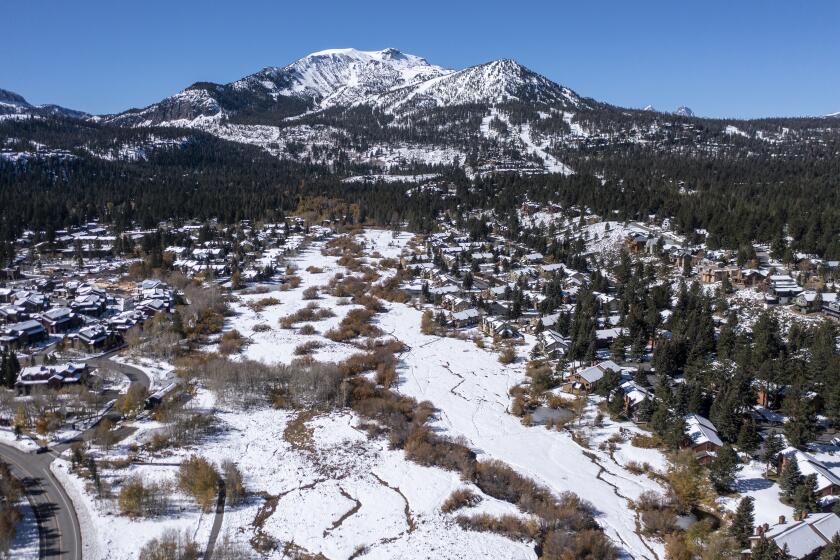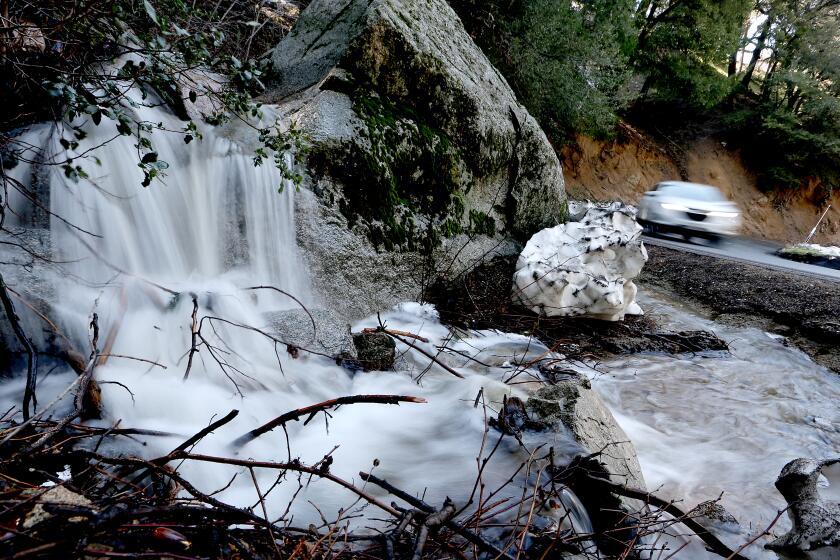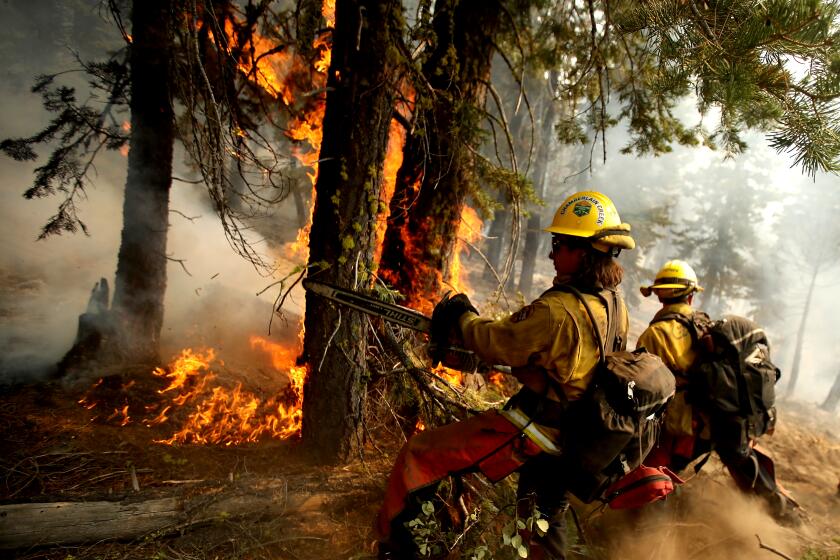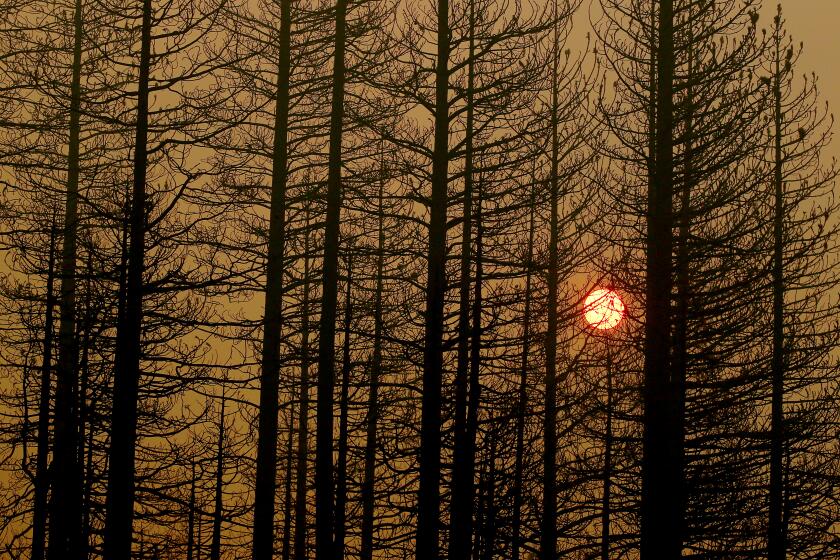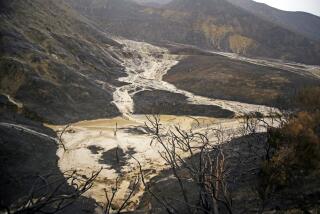California’s snowpack is melting faster than ever before, leaving less available water
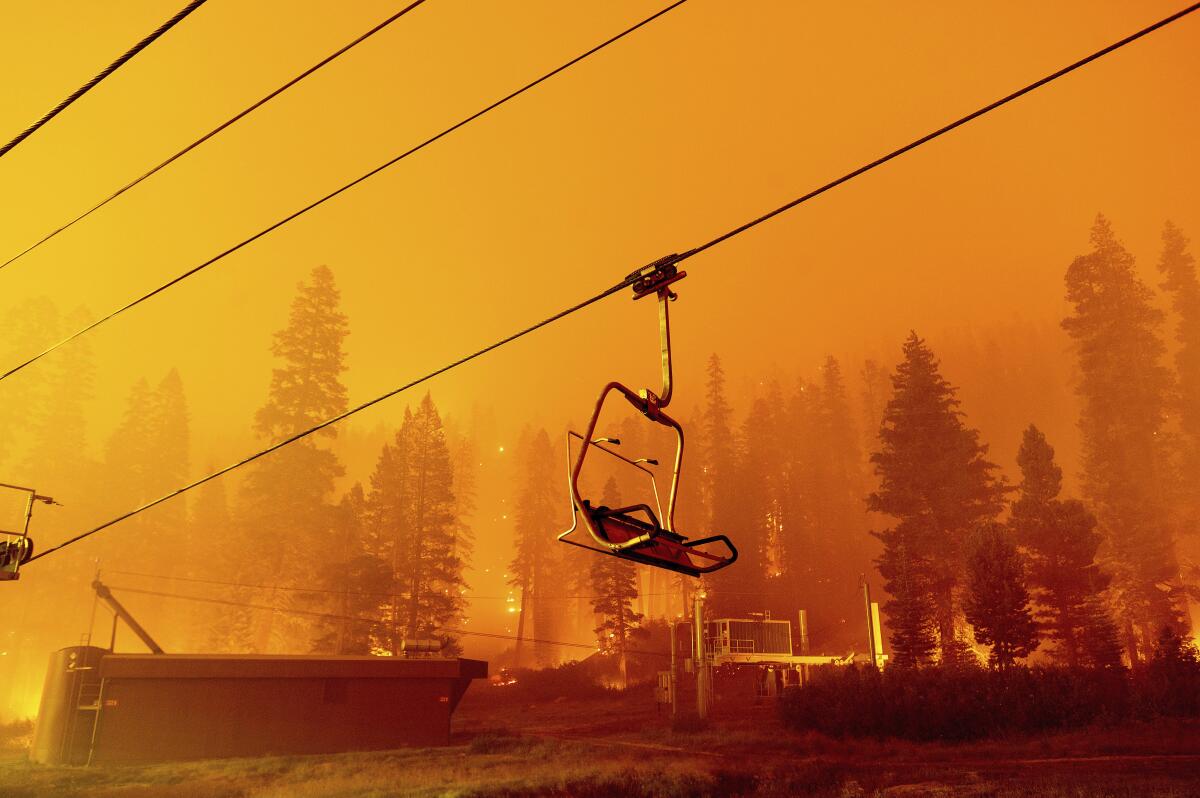
- Share via
For decades, Californians have depended on the reliable appearance of spring and summer snowmelt to provide nearly a third of the state’s supply of water. But as the state gets drier, and as wildfires climb to ever-higher elevations, that precious snow is melting faster and earlier than in years past — even in the middle of winter.
That’s posing a threat to the timing and availability of water in California, according to authors of a recent study in the journal Geophysical Research Letters, which found that the effects of climate change are compounding to accelerate snowpack decline.
“As wildfires become larger, burn at higher severities, and in more snow-prone regions like the Sierra Nevada, the threats to the state’s water supply are imminent,” said Erica Siirila-Woodburn, a research scientist with the Lawrence Berkeley National Laboratory and one of the authors of the study.
The timing of snowmelt is critical in California because it typically provides water in hot, dry months when precipitation is low and demand is high, Siirila-Woodburn said. “So, if snow melts earlier in the year, then there is a further disconnect between that supply and demand, potentially causing water scarcity issues.”
New research has found that winters of low snow, or even no snow, could become a regular occurrence in California in as little as 35 years.
There are several systems at work to create this unwanted effect, including climate change, forest management practices and worsening drought and wildfires. In 2020 and 2021, the state saw a nearly tenfold increase in wildfire activity in snowy places compared with the years 2001-19, according to the study.
The burn scars of those fires are increasingly meeting with midwinter droughts, or periods when rain and snow stop falling in the midst of the state’s wet season. Last year, for example, a wet December gave way to the state’s driest January through March on record.
That in effect shifts the “melt season” into the middle of winter, said Benjamin Hatchett, an assistant research professor at the Desert Research Institute and one of the study’s lead authors. It also has the potential to turn mountain snow from a resource into a hazard.
“We’re going to be getting a lot more water potentially earlier in the season, so it’ll put [us] out of the phase when we want that water and when we need it, and when it’s actually coming out of the mountains,” he said.
California’s snowmelt is leading to flooding and erosions. The Central Valley and Yosemite are dangerously affected, but the water can benefit drought-battered farmers.
The Caldor fire, which seared through 222,000 acres near South Lake Tahoe in the fall of 2021, is a perfect example of the effect. When snow fell onto the fire’s burn scar that winter, it was exposed to more sunlight due to the lack of tree canopy. Charred vegetation from the fire also mixed with the snow to lower its reflectivity. As a result, the snow melted much faster than during a comparable midwinter dry spell in 2013.
In fact, the study found that the reflectivity of snow — also known as albedo — declined as much as 71% when it fell onto burned areas, leading to fewer snow-covered days. The enhanced snowmelt was so pronounced within the Caldor fire burn scar that researchers recorded 50 fewer days with snow cover that winter, the lowest number of snow cover days on record in the area.
“We have a lot more area that’s now exposed to these potential dry periods and post-fire environments that can lead to melting of the snow,” Hatchett said. “So we should start thinking about how we are going to deal with this, because we expect more dry periods in a warmer climate and we expect more fire in the mountains, so it’s giving us reasons to think about how were manage our forests, how we manage our water resources.”
Wildfires are increasing streamflow throughout the western U.S., raising new threats for public safety and water management, according to researchers.
Indeed, earlier-than-usual snowmelt can lead to a “whole chain of cascading impacts” in addition to reduced water availability, he said, including reduced resources for hydropower and negative effects on fish species.
One of the researchers’ key recommendations is that water managers factor the effects of wildfires on snowmelt into their short- and long-term planning, as the effects are unlikely to reverse any time soon.
The study joins a growing body of work that examines the ways in which climate change is upending long-held relationships among wildfire, water and drought in California. The state’s blazes are climbing to ever-higher elevations and increasing the chances of hazardous runoff, while drought is making the prospect of a “no-snow” winter more likely within the coming decades.
John Abatzoglou, an associate professor of climatology at UC Merced, who did not work on the study, said some of the findings “suggest that we might have to retool how we translate midwinter snowpack into spring melt, runoff and water availability.”
Abatzoglou in 2021 published a study that found that climate warming has exposed an additional 31,400 square miles of U.S. forests to fires at higher elevations. That study also found that between 1984 and 2017, fires in the Sierra Nevada advanced in elevation by more than 1,400 feet.
He said the effect of lower albedo in midwinter could make the snowmelt more vulnerable to “rain on snow events” and create challenges for reservoir management. Less water in mountain snowpack is compounding observed warming trends and highlighting the “importance of the water shortage problem that the state faces,” he said.
And although some studies have shown that the effect of fire on snow wanes over time, the early disappearance of snow could transform some ecosystems recovering from fire, Abatzoglou said.
“This is very site specific, but some species do much better with ample soil water into summer to generate,” he said. “The early disappearance of snow doesn’t help on this front.”
Climate warming has exposed an additional 31,400 square miles of forests to fire at higher elevations, where flames are scorching terrains that previously were too wet to burn.
There is no silver bullet for fixing the issue, said Siirila-Woodburn, who also worked on the study about the potential for a “no-snow” California.
However, “approaches like forecast-informed reservoir operations, managed aquifer recharge at scale, and widespread water treatment involving lowering the cost and energy associated with desalination of unconventional water sources are valuable paths forward to build water resource resilience,” she said.
Kristen Guirguis, an associate project scientist at Scripps Institution of Oceanography and another of the study’s authors, said the findings build on previous research about “weather whiplash,” or worsening climate extremes in California. Research has found that the characteristics of California’s precipitation are changing, and the frequency of dry days is increasing, she said.
The latest paper “is the first time I’ve seen it quantified that having a fire changed the properties of the snow and the snow environment in a way that made snowmelt accelerate,” she said.
“It was a pretty strong signal — you can clearly see the acceleration of snowmelt in those fire-impacted regions,” she said.
But while climate change plays a significant role in the process, it’s not the only factor. Hatchett said failures of forest management, including policies that allowed for a century’s worth of vegetation to build up forests, are also contributing to this worsening effect.
He said the findings underscore the need to bring “good fire” back to the landscape — meaning prescribed burns or cultural burns that allow for low-severity fires to improve forest health. That will “make our forests more resilient so that we don’t have to have severe fire that causes these really long-term damages,” he said.
Still, he said, the findings “should be a bit terrifying.”
“I hope it motivates people to think about how we can learn from what we’re seeing now,” he said. “To modernize our land management, get good fire back onto the land, and really make our forests and water supply and environment more resilient to whatever climate change is going to throw at us.”
More to Read
Sign up for Essential California
The most important California stories and recommendations in your inbox every morning.
You may occasionally receive promotional content from the Los Angeles Times.
